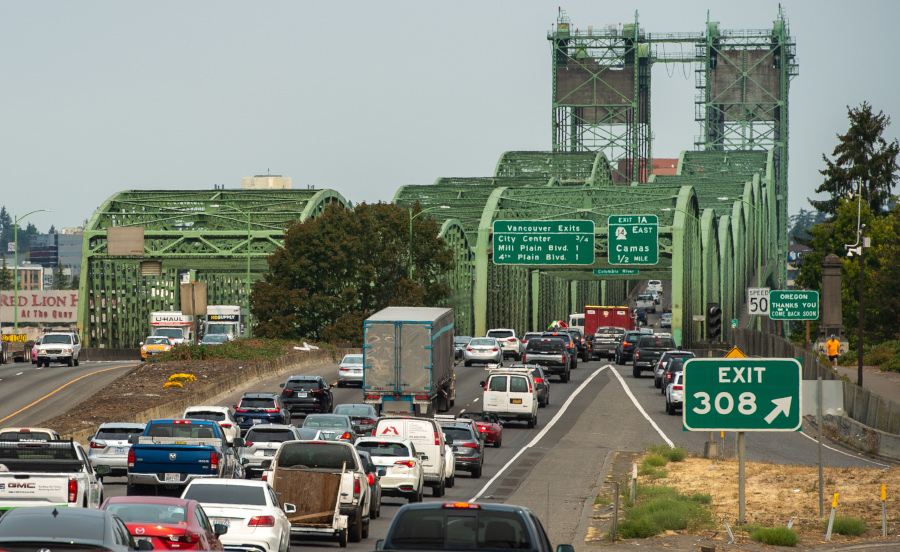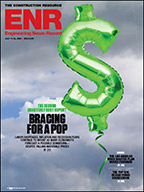Ninety-six employees of the ill-fated Columbia River Crossing, or CRC, project must now pack up their Vancouver, Wash., headquarters due to the sudden demise of a $3.5-billion bi-state project aimed at constructing a new bridge, light-rail and highway interchange to span the Columbia River and also connect Portland, Ore., to Vancouver. Legislators, transportation insiders and commuters are analyzing what killed one of the nation's largest transportation projects and what they can do now to unblock chronic congestion on Interstate 5.
With more than $175 million spent since 2004, the plan to replace a pair of two-lane bridges, built in 1917 and 1958, with a 10-lane, light-rail-inclusive span officially fizzled during the waning hours of June, after the Washington state Senate failed to vote on a $10-billion transportation bill that included $450 million for the CRC. Oregon had agreed to fund its portion of the partially federally funded project in March. But without Washington state, Oregon Gov. John Kitzhaber (D) and Washington Gov. Jay Inslee (D) both declared the project cancelled.
The CRC's future? There is no future, says CRC spokesperson Mandy Putney. "We have 96 staff, computers, desks, files, and we are trying to determine where to put everything," she says. "All the files need to be stored and archived and made available if needed."
Putney expects the office—with staff representing Portland agency TriCounty Metropolitan Transportation District of Oregon; Oregon Dept. of Transportation; Washington State Dept. of Transportation; Vancouver, Wash.-based Clark County Public Transit Benefit Area Authority and 14 development agencies—to close most operations by August.
While climbing project costs, prolonged deadlines and contested tolling figures all plagued the project, the two main bullets that took the CRC down were Oregon's insistence on light-rail inclusion and several design mistakes. The original open-web box design was scrapped after independent reviews found it too tricky and costly to construct (ENR 2/14/11 p. 9). The 16-member panel recommended three alternatives, and the CRC chose a basic composite-deck truss scheme. The design was uninspiring, but it placed costs closer to $2 billion for the bridge portion alone.
But the U.S. Coast Guard adamantly opposed allowing the planned bridge height of 95 ft, saying it would impede river traffic (ENR 3/26/12 p. 11). That resulted in a review and revision to 116 ft, including mitigation for downstream businesses. But even the 116-ft height could have negative long-term impacts, opponents say.
One of the limiting factors in bridge height was a direct result of the insistence on accommodating light rail, which imposed a limit on the slope. "Because of … the inability of light rail to climb a grade, yes, I believe it was light rail that ultimately killed the project," says Rep. Don Benton (R-Vancouver). "It is a bad idea to let alternative modes become the primary driver on a highway project."
Across the board, Washington state's new Republican majority didn't want to bear the cost of light rail, especially for the largely rural southwest portion of the state that doesn't have such service. "This gives me a glimmer of hope we can still figure out how to get this right," says Rep. Paul Harris (R-Vancouver). "This obviously was not the right project, and we can work on a common-sense option."
But the two governors see the flopped project as a loss for citizens. Kitzhaber released a statement saying Washington lawmakers "failed" to address the need for an essential new bridge. Inslee is "beyond disappointed" with his state's inaction, which cost the project $850 million in federal funds.
Rep. Jim Moeller (D-Vancouver) says any alternatives are just talk and the CRC is the only viable proposal on the table. He says Republicans used light rail as a "red herring," since most of that portion was covered by federal funds.
Consultants’ Costs
Of the $175 million already spent, $37 million went to Portland-based David Evans and Associates, which referred all ENR questions to the CRC team. The firm's subcontractors collected another $77 million, including $22 million to Parsons Brinckerhoff, according to CRC documents.
Some of the consulting work's geotechnical data could still prove useful in the future. Portland's Shannon & Wilson used its $4.8-million contract to produce data from large-diameter test shafts drilled more than 250 ft deep, says Gary Peterson, a senior vice president. "The data will be useful on this alignment in the future. Obviously, a major alignment change would render the tests invalid."
But no one is expecting a new proposed megaproject. While both state departments of transportation remain silent on the corridor's future, Kitzhaber has called for ODOT to "review all of the work on the Oregon side of the project to determine if any stand-alone investments could be made to improve safety and reduce congestion [but] on a smaller scale."
What is next—including the possibility of multiple bridges—is up in the air. Whether a new proposal would keep the alignment near the current two bridges and what modes of transportation the new crossing would carry will be questions for a new leadership team.
George Crandall, an urban designer and principal architect at Crandall Arambula, Portland, opposed the CRC project. He says it isn't a matter of selling one alternative over another but of having a discussion to find "cheaper options and [phased] alternatives."
Other Options
Joe Cortright, president of Portland-based Impresa Inc., a transportation consulting firm that also opposed the CRC, says some steps are universally agreed on.
Oregon's Hayden Island currently can be accessed only via I-5, putting local traffic on an already congested highway system. Even the CRC plan called for adding a local bridge connecting the island to Portland to move traffic away from I-5.
Proponents of smaller-scale projects also want to see fixes to a downstream BNSF railway bridge to eliminate over 85% of all lifts of the current I-5 bridge. The railroad bridge's pivot point sits near the Oregon shore, which means river traffic must make an S-curve from the midpoint of the I-5 bridge—its tallest section—to the opening in the railroad bridge. When river conditions don't allow the tricky maneuver, the I-5 span lifts near the Oregon side, halting interstate traffic. Moving the pivot point would eliminate the S-curve.
"These are easy things to do," Crandall says. "There are things that could happen almost immediately."
Cortright calls the CRC cancellation "emblematic" of a shift in how transportation projects will move forward in the future, opting for smaller, phased projects when funding already exists. Cortright wants to also see changes made to traffic flow, including running HOV lanes all the way across the bridge and closing off the final northbound on-ramp before driving onto the bridge.
But there's still the concern about what to do with congestion on the freeway, even if projections say that tolling a new bridge would keep traffic volumes at current rates, which have dropped to 2000 levels. By bringing the two current structures into compliance with seismic codes—at a cost of about $300 million, according to the project's environmental impact statement—placing a third bridge somewhere in the corridor to distribute traffic would serve as a final piece.




